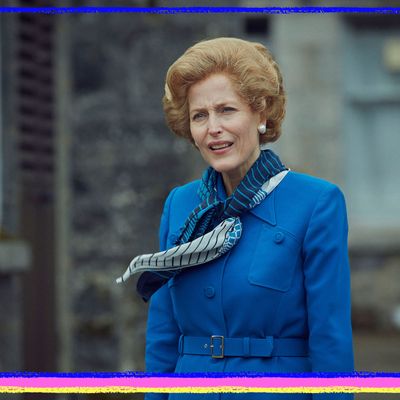
There’s one silhouette that looms tall over the fourth season of The Crown, one distinctive, immediately recognizable shape that defines this era of British history: Margaret Thatcher’s hair. It is lofty yet firm, a high-rise construction that’s easy to compare to a helmet, but is in fact more like an edifice. It is a signal of Thatcher’s impenetrability, her self-control and self-possession. It is not hair that admits weakness, and it is not designed to be beautiful. It is functional, and its function is to project strength.
Nailing Thatcher’s precise, familiar hairstyle was a key element in bringing the character to life on The Crown, and it was crucial to help transform actor Gillian Anderson into the recognizable prime minister. “It’s my favorite thing. It’s my favorite thing in the whole season,” The Crown’s hair and makeup designer Cate Hall told me. “And it was definitely the hardest.”
The trouble with Thatcher’s wig began early, when Hall heard back from The Crown’s showrunner Peter Morgan about her first attempt at getting the wig right. “We started with a very traditional hair and makeup approach. We did the set, the roller set, and it looked glossy and beautiful and amazing. Everyone was like, ‘Wow you’re amazing,’ and then Peter Morgan phoned and was like, ‘It’s not right.’ We said, ‘Oh god! Oh dear Lord, no!’”
Part of the issue was that many people have strong memories of Thatcher and what her hair looked like, but depending on your age and how closely you paid attention, those memories could be completely different. “Her color changed constantly because it was out of a bottle,” Hall said, and while older people tend to remember her as blonde, younger people think of her as a redhead. “I remember her being a redhead,” Hall said, “but actually from the photos I know that it changed all the time.” So Thatcher’s wig had to undergo what Hall describes as “a subtle transition of color throughout the series.”
“Poor wigmakers had to do about eight different blends of colors. And then,” Hall said, “we just destroyed it. Peter [Morgan] was saying, ‘Go further, go further with the texture.’ So we would cinch it, backcomb it, put the wig up but with no water so that it was even more destroyed, to get that kind of damaged silhouette that actually is what is so, I think, captivating and recognizable. That was entirely down to Peter just saying, ‘Keep trying, keep trying.’”
But that slow transition of color is not just an external way of thinking about Thatcher’s change over the decade. The softer, blonder hair had to reflect a slightly less severe image of who she was at the start of her political career. Morgan told Hall that the season was starting in 1979, “and it was this world of promise and hope.” The makeup and hair could not already be a judgment on Thatcher, carrying all the knowledge of what was going to happen later. It had to leave room for an initial openness, something just a touch more natural that could later harden into the Thatcher of the late ’80s.
For all the hard work that went into creating Thatcher’s hair, the process of donning it and applying the makeup was straightforward and quick. Thatcher has a particular way of setting her mouth, of holding her neck and cheeks so that her smile falls somewhere in the territory of a grimace. But Anderson didn’t use any mouthpiece or makeup aid to create that look.
“People think she had prosthetics because she’s so beautiful,” Hall said, “but she doesn’t! She just did it. There’s nothing. In fact, the makeup actually takes like ten minutes.” Aside from thinning out the wig’s hairline for the show’s final episode to make Thatcher’s hair recede a bit, the destroyed stiffness of the wig made it very easy to put on. “It was so enjoyable to stop doing perfect, manufactured period gloss,” Hall said. “There was no gloss. It’s just that commitment to reality that, I just love it. That was a real thrill for me.”


